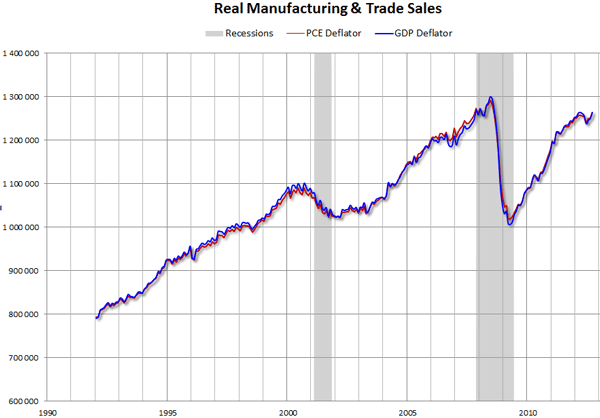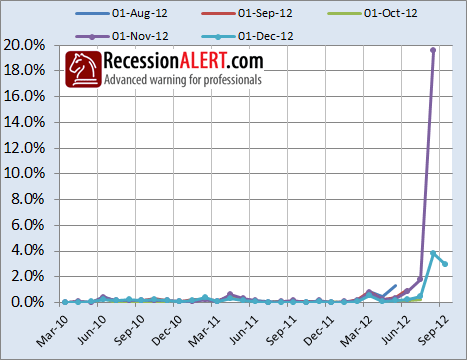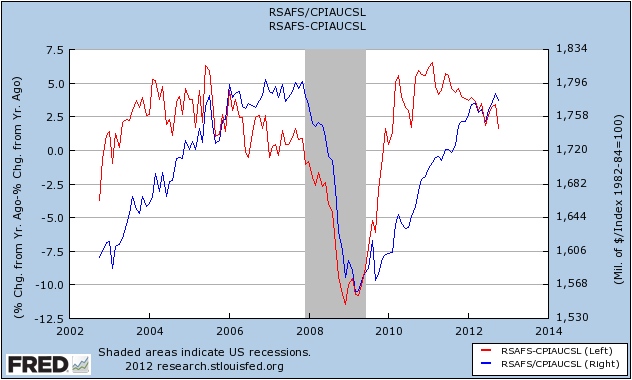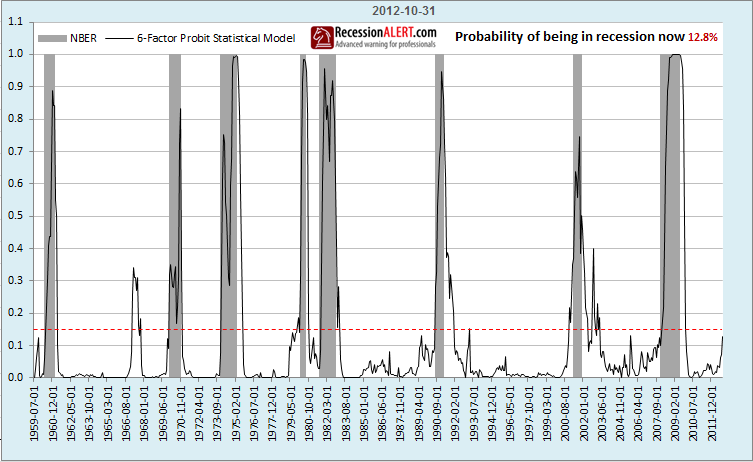Professor Piger updated his recession probability model that caused so much attention early November (See “Debunking 100% probability of recession“). As we forecast last month, the probability index undertook a “revision” of epic proportions as displayed below (01-Dec-12 vintage):
This is a classic real-world rendition as to why you cannot make “never before has recession probability reached 20% without a recession ensuing shortly after ” type inferences with these Markov model readings, and why the developers of the model use 3 or more readings above 80% before making recession calls. Hopefully last month was the last time we see misinformed bloggers jumping to wild conclusions and scaring everyone witless with baseless inferences without doing their homework.
The reasons for the dramatic drop in recession probabilities were of course the inclusion of better data from September. Because of a two-month delay in the availability of the manufacturing and trade sales series, the probabilities of recession were also available only with a two-month delay. So the reading in early November we saw that caused so much fright applied to the economy as at August 2012. We had one set of extra data readings since the scary reading was published that were not yet incorporated into the model. As we stated last month, this data was likely to have a favourable effect on the model and drop probabilities down to 10% from 19%. The reason the probabilities dropped even further is likely to do with the fact that Real manufacturing and Trade sales printed a new high at the data point published on Friday:

(Chart courtesy of Doug Short)
It is with some interest that we noted ECRI pointing to Sales as having peaked in their defence of recession call last week. I looked very hard at their peak indicator of Sales published on their web site last week and struggled to find the remotest inference of a peak in their chart, no matter how creative I got with my geometry skills. With this latest print from Real manufacturing and trade sales forming a new high (it was published after ECRI did their rounds last week) I find this even more baffling. No doubt the November figure for the more timely monthly Retail and Food Services Sales[NAIC based] used by the NBER and our “NBER Model : Recession Confirmation of last resort” and published around the middle of December will be more telling. Whilst the chart below shows growth slowing (red line), the growth is still well above a negative print and the blue line offers absolutely no sound geometric reason for a peak inference right now.
I’m not denying recession risks right now, but do get a little frustrated when weak arguments for the case are put forward by industry professionals and broadcast on mainstream TV. It leaves the impression one is clutching at straws. You could trot out a half-dozen cases right now for recession far more compelling than a non-existent peak in retail sales (conversely we could roll out 2 dozen cases for expansion!) On that note, we have a full month of October data for our NBER model maintained for clients. On Friday we released the full report to them, but below is a snapshot of the recession probability section of the report:
The red dotted line is the “Never before” inference line – in other words when probabilities exceed this line, recession has always followed very shortly thereafter, bar one occasion in 1966. If the red line were moved to 35% then you would have a level that has never made a false alarm (false positive) in the past. We can make these kinds of inferences as this model is not subject to the large revisions in the Markov models, it is merely subject to the data revisions themselves. As we have comprehensively researched in a prior note – these revisions are not as dramatic as some would lead us to believe and have little effect around turning points for the NBER Model.
I am more inclined to think the levels posted by this Probit model (12.8%) are more representative of risk right now than the Markov models’ 3%. But we do not have to wait until the 15th Dec to get a comprehensive November view of the economy – our Labour Report which gets published on 7th December will include a battery of BLS data that can be combined into a comprehensive and broad US economic composite. Its the earliest possible time to achieve a broad view of the economy status for the prior month. If you go to the OUR SERVICE menu you can download a copy of the report from last month to see what it is saying through the lens of the labor market.




Comments are closed.